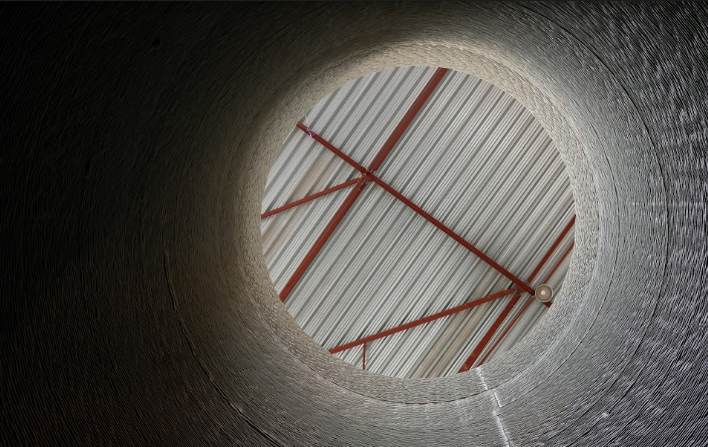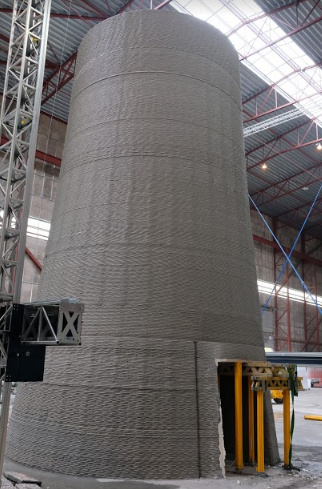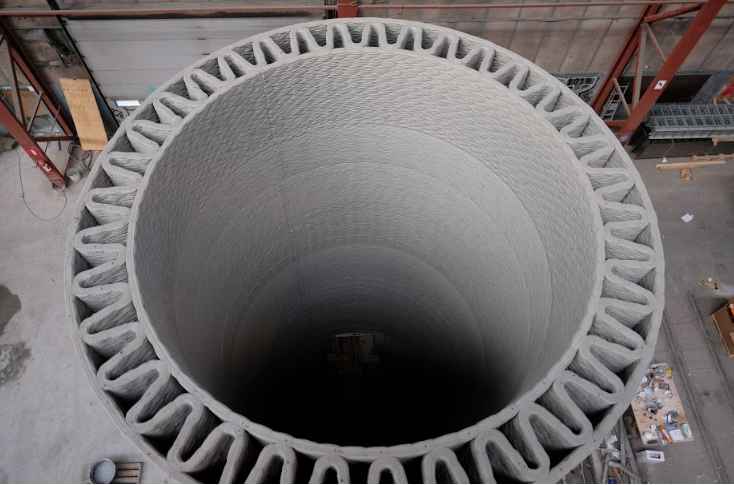Wind turbines can be extremely effective but they must be able to stand up to the elements, meaning that finding the correct materials for long-term use can be challenging. Currently, the height of most turbines is limited to around 100 meters, constructed from steel or precast concrete. This is all about to change, however, as GE Renewable Energy, COBOD, and LafargeHolcim collaborate in 3D printing optimized concrete bases that will reach as high as 200 meters.
Although the first prototype was already completed last October in Copenhagen, in this multi-year project the partners are planning on creating another prototype, featuring a 3D-printed pedestal. Following that, they will also be creating a ‘production-ready printer,’ along with materials suitable for use. Ultimately, the goal is to build taller towers that will produce greater amounts of renewable energy.
As engineers around the wold seek alternative ways to produce energy—without pollution—renewable sources like wind turbines are becoming more widely seen around the world. If you live in an area without wind turbines and suddenly come upon one or a series of them in a state like Texas or California, for instance, you may find yourself transfixed by these stalwart structures. In most cases for wind turbines, bigger is more beneficial in terms of covering more territory and harnessing more energy.
“Concrete 3D printing is a very promising technology for us, as its incredible design flexibility expands the realm of construction possibilities. Being both a
user and promoter of clean energy, we are delighted to be putting our material and design expertise to work in this groundbreaking project, enabling cost efficient construction of tall wind turbine towers and accelerating access to renewable energy,” explained Edelio Bermejo, Head of R&D for LafargeHolcim.
Each of these partners brings powerful experience to any industrial project. In producing the 3D-printed turbines, each company will be responsible for the following:
- GE Renewable Energy – providing design, manufacturing, and commercialization expertise
- COBOD – developing robotics automation and 3D printing processes
- LafargeHolcim – designing customized concrete materials, along with processing and application of during the project
“We are extremely proud to be working with world-class companies like GE Renewable Energy and LafargeHolcim,” said Henrik Lund-Nielsen, founder of COBOD International A/S. The Danish company recently reported outstanding growth in 3D printing for construction, with orders tripling this year for their BOD2 construction printer.
“With our groundbreaking 3D printing technology combined with the competence and resources of our partners, we are convinced that this disruptive move within the wind turbines industry will help drive lower costs and faster execution times, to benefit customers and lower the CO2 footprint from the production of energy,” continued Lund-Nielsen.
3D printing has been associated with wind turbines over the past few years, including projects that involve fabrication of enormous molds for wind turbine blades, 3D-printed installations for remote locations, and even echolocation devices meant to ward off animals like bats. Other engineering projects have targeted turbines for improvement too, as firms like Michigan-based Barton Malow have developed a method for standardizing the construction of wind turbines platform through the use of constructible kits.
Turbine towers have previously been constricted in size due to transportation and affordability issues. As this dynamic trio of leaders work together, however, the base will be 3D printed on-site—and rather than generating the typical 15.1 GWh, the new turbine is expected to produce 20.2 GWh, which translates to 33 percent more power.
“3D printing is in GE’s DNA and we believe that Large Format Additive Manufacturing will bring disruptive potential to the Wind Industry. Concrete printing has advanced significantly over the last five years and we believe is getting closer to have real application in the industrial world. We are committed to taking full advantage of this technology both from the design flexibility it allows as well as for the logistic simplification it enables on such massive components,” said Matteo Bellucci, Advanced Manufacturing Technology Leader for GE Renewable Energy.
The project will obviously have to find some balance in terms of carbon footprint, as the partners strive to generate more renewable energy, they will have to consider the CO2 generated by the concrete itself. As one Guardian author put it, “If the cement industry were a country, it would be the third largest carbon dioxide emitter in the world with up to 2.8bn tonnes, surpassed only by China and the US.”
What do you think of this news? Let us know your thoughts! Join the discussion of this and other 3D printing topics at 3DPrintBoard.com.
[Source / Images: COBOD]Subscribe to Our Email Newsletter
Stay up-to-date on all the latest news from the 3D printing industry and receive information and offers from third party vendors.
You May Also Like
Precision at the Microscale: UK Researchers Advance Medical Devices with BMF’s 3D Printing Tech
University of Nottingham researchers are using Boston Micro Fabrication‘s (BMF) 3D printing technology to develop medical devices that improve compatibility with human tissue. Funded by a UK grant, this project...
3D Printing Webinar and Event Roundup: April 21, 2024
It’s another busy week of webinars and events, starting with Hannover Messe in Germany and continuing with Metalcasting Congress, Chinaplas, TechBlick’s Innovation Festival, and more. Stratasys continues its advanced training...
3D Printing Webinar and Event Roundup: March 17, 2024
It’s another busy week of webinars and events, including SALMED 2024 and AM Forum in Berlin. Stratasys continues its in-person training and is offering two webinars, ASTM is holding a...
3D Printed Micro Antenna is 15% Smaller and 6X Lighter
Horizon Microtechnologies has achieved success in creating a high-frequency D-Band horn antenna through micro 3D printing. However, this achievement did not rely solely on 3D printing; it involved a combination...

































